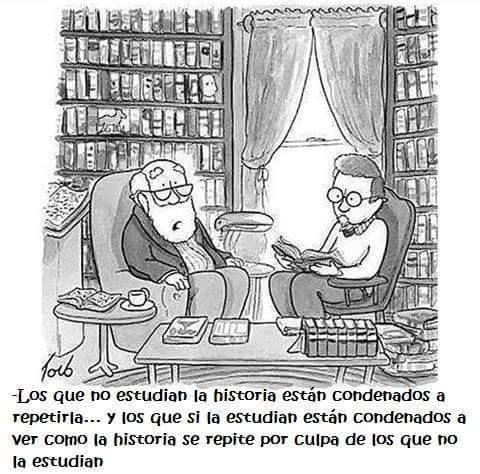“…A Pesar De Lo Que Comúnmente Se Piensa, La Dictadura De Porfirio Díaz Es El Regreso Del Pasado.

“…A pesar de lo que comúnmente se piensa, la dictadura de Porfirio Díaz es el regreso del pasado. En apariencia, Díaz gobierna inspirado por las ideas en boga: cree en el progreso, en la ciencia, en los milagros de la industria y del libre comercio. Sus ideales son los de la burguesía europea. Es el más ilustrado de los dictadores hispanoamericanos y su régimen recuerda a veces los años de la “belle époque” en Francia. Los intelectuales descubren a Comte y Renan, Spencer y Darwin; los poetas imitan a los parnasianos y simbolistas franceses; la aristocracia mexicana es una clase urbana y civilizada. La otra cara de la medalla es muy distinta. Esos grandes señores amantes del progreso y la ciencia no son industriales ni hombres de empresa: son terratenientes enriquecidos por la compra de los bienes de la Iglesia o en los negocios públicos del régimen. En sus haciendas los campesinos viven una vida de siervos, no muy distinta a la del período colonial. Así, desde el punto de vista “ideológico”, el porfirismo se ostenta como el sucesor legítimo del liberalismo. La Constitución de 1857 sigue vigente en teoría y nada ni nadie pretende oponer a las ideas de la Reforma principios distintos. Muchos, sin excluir a los antiguos liberales, piensan de buena fe que el régimen de Díaz prepara el tránsito entre el pasado y la sociedad moderna. En realidad, el porfirismo es el heredero del feudalismo colonial: la propiedad de la tierra se concentra en unas cuantas manos y la clase terrateniente se fortalece. Enmascarado, ataviado con los ropajes del progreso, la ciencia y la legalidad republicana, el pasado vuelve, pero ya desprovisto de fecundidad. Nada puede producir, excepto la rebelión…”
Octavio Paz, El Laberinto de la Soledad.
More Posts from Fernandoalbertorodriguez and Others

¡Felicidades a los papás memexicanísimos!
ARMI http://ift.tt/1UInxyD


PLACES IN THE ANCIENT WORLD: Cuicuilco (Mexico)
CUICUILCO is an ancient settlement site in central Mexico, now located in southern Mexico City. Prominent in the late pre-Classic period, around 500 BCE, it is noted for its large circular temple mound, one of the earliest monumental structures in ancient Mesoamerica and influential on many later pyramid monuments built by the Maya and Aztecs amongst others. Buried in several metres of lava and abandoned Cuicuilco remains one of the most enigmatic early urban centres in the Americas.
Cuicuilco was inhabited just at the period when Mesoamerican villages were transforming into larger population centres which would in turn become the great cities of the region in later centuries. At its height the town may have had a population of up to 20,000 people, its prosperity based on the fertile land in the surrounding lagoon basin of the Mexico Valley.
Read More
Article by Mark Cartwright on AHE
UN INTERESANTE Y BREVE VIDEO. SALUDOS.

EL TAMAÑO DE UNA IMAGEN CON PROFUNDIDAD DE CAMPO DEL TELESCOPIO ESPACIAL HUBBLE EN RELACION AL RESTO DEL CIELO NOCTURNO.
The size of Hubble’s Deep Field image in relation to the rest of the night sky


May 15, 1911: The revolutionary forces of Francisco Madero massacre over 300 Chinese residents of Torreón, Mexico.
In late 1910, with defeated Mexican presidential candidate Francisco Madero at its head, a diverse coalition launched what would unravel into the decade-long Mexican Revolution. Its fundamental consensus was that the regime of President Porfirio Díaz, which represented the dregs of colonial legacy, elitist Europeanism, and foreign collusion over the interests of Mexico, must be deposed.
Underlying these basic grievances was the even more fundamental, yet infinitely more complex, question of what the new Mexican nation should be. The thirty-four year-long Porfiriato dictated its national and social aims based on a strict positivist vision of progress, privileging all that was European and modernization in the image of the European. The questions facing those who now sought to overthrow Díaz were therefore charged with issues of race, xenophobia, and lo mexicano and mexicanidad. As the new revolutionary Mexico emerged - a nationalist Mexico, which now embraced the ordinary middle and lower classes and Mexico’s indigenous populations over the European-aligned upper classes - fissures elsewhere fractured violently open.
Some 10,000 to 40,000 Chinese resided in Mexico by 1910. President Díaz had hitherto welcomed enthusiastically both foreign capital and the foreign cheap labor provided by this stream of Chinese migrants. As was the pattern across the Americas, the Chinese lived and labored in mostly isolated cultural enclaves. At the same time, many Chinese workers managed to accumulate some capital and open businesses both large and small. By the time of the Mexican Revolution, a strong anti-foreign sentiment - directed at not only Americans but Asians who, like the Americans, appeared to be profiting and thriving at the expense of ordinary Mexicans - was clearly brewing.
Between May 13 to May 15, as Díaz’s exit became imminent, maderista troops took the northern city of Torreón, and in the process massacred an estimated 303 Chinese in addition to 5 Japanese residents who became conflated with the Chinese population. Lebbeus R. Wilfley described in his investigations of the massacre that “soldiers shot them as they would rabbits for sport and for practice in marksmanship,“ and then after the “carnival of slaughter ended [the soldiers] … robbed the dead.” A mob of over 4,000 civilians accompanied the soldiers and, incited by calls to “exterminate” this alien population of exploiters and profiteers, attacked Chinese businesses and slaughtered indiscriminately, despite some individual efforts by civilians to protect them.
The massacre ended by order of Emilio Madero, who then placed survivors under military protection, but the sentiment remained. While the scale of violence that took place at Torreón was never repeated, attacks against Chinese property and individuals continued through the revolution. In the years following, calls for exclusion or expulsion escalated, and the Chinese government, itself confronting foreign encroachment across the Pacific, could do very little to protect its overseas nationals.

Amor…
ARMI http://ift.tt/29keHJP

ASESORÍA JURÍDICA Y ASISTENCIA LEGAL GRATUITA
Con el objetivo de garantizar el derecho a la protección jurídica de las familias, la Defensoría Pública del Gobierno del Estado ofrece a todos los ciudadanos asesoría jurídica y asistencia legal de manera gratuita y con un alto grado de calidad y eficiencia en su servicio,
Francisco Rueda Gómez Secretario General de Gobierno así lo dio a conocer, afirmando que son muchos los servicios que se ofrecen en la defensoría pública, los ciudadanos pueden contar con un abogado que los asesorará a realizar sus trámites de manera ágil eficaz y gratis.
Asesoría en juicios de prescripción positiva, jurisdicción voluntaria, asesoría para trámite de divorcio necesario o voluntario; trámite de pensión alimenticia, asistencia legal a personas sujetas a averiguación previa ante el Ministerio Público, asistencia en trámite de juicios intestamentarios, entre otros.
En el recorrido de Rueda Gómez por las áreas de la Defensoría Pública, el funcionario estatal conminó al titular de la Defensoría Pública del Estado, Jesús Alejandro Santos Díaz, así como a los abogados defensores públicos que ahí prestan sus servicios, a seguirlo haciendo con profesionalismo y un alto grado de sentido social.


Consejo memexicanisimo del día:
ARMI http://ift.tt/293G9NV
-
 vodoolorca liked this · 2 months ago
vodoolorca liked this · 2 months ago -
 miellsworld reblogged this · 2 years ago
miellsworld reblogged this · 2 years ago -
 the-borderline liked this · 5 years ago
the-borderline liked this · 5 years ago -
 onionsoupsoup reblogged this · 5 years ago
onionsoupsoup reblogged this · 5 years ago -
 onionsoupsoup liked this · 5 years ago
onionsoupsoup liked this · 5 years ago -
 dizantino liked this · 5 years ago
dizantino liked this · 5 years ago -
 ric-martinez liked this · 5 years ago
ric-martinez liked this · 5 years ago -
 aldairhdz27 liked this · 6 years ago
aldairhdz27 liked this · 6 years ago -
 gemini-in-tauro liked this · 6 years ago
gemini-in-tauro liked this · 6 years ago -
 sethcaminantedeluniverso liked this · 8 years ago
sethcaminantedeluniverso liked this · 8 years ago -
 eddyeddy67 reblogged this · 8 years ago
eddyeddy67 reblogged this · 8 years ago -
 fernandoalbertorodriguez reblogged this · 9 years ago
fernandoalbertorodriguez reblogged this · 9 years ago -
 fernandoalbertorodriguez liked this · 9 years ago
fernandoalbertorodriguez liked this · 9 years ago -
 777rex-blog liked this · 9 years ago
777rex-blog liked this · 9 years ago -
 sofiarctic liked this · 9 years ago
sofiarctic liked this · 9 years ago -
 sofiarctic reblogged this · 9 years ago
sofiarctic reblogged this · 9 years ago -
 anavicarious reblogged this · 9 years ago
anavicarious reblogged this · 9 years ago -
 vodoolorca reblogged this · 9 years ago
vodoolorca reblogged this · 9 years ago -
 abbyob reblogged this · 9 years ago
abbyob reblogged this · 9 years ago -
 a-marine-dream reblogged this · 9 years ago
a-marine-dream reblogged this · 9 years ago -
 a-marine-dream liked this · 9 years ago
a-marine-dream liked this · 9 years ago -
 michael-wolfenschreiben liked this · 9 years ago
michael-wolfenschreiben liked this · 9 years ago -
 lost-in-the-funhouse liked this · 9 years ago
lost-in-the-funhouse liked this · 9 years ago -
 juventudmalgastada liked this · 10 years ago
juventudmalgastada liked this · 10 years ago -
 julianrdz21 liked this · 10 years ago
julianrdz21 liked this · 10 years ago -
 julianrdz21 reblogged this · 10 years ago
julianrdz21 reblogged this · 10 years ago -
 frankeane liked this · 10 years ago
frankeane liked this · 10 years ago -
 waiijessi reblogged this · 10 years ago
waiijessi reblogged this · 10 years ago -
 eddyeddy1967 reblogged this · 10 years ago
eddyeddy1967 reblogged this · 10 years ago -
 azazzaa liked this · 10 years ago
azazzaa liked this · 10 years ago -
 erick-dvbbs-blog liked this · 10 years ago
erick-dvbbs-blog liked this · 10 years ago -
 bocchanworld liked this · 10 years ago
bocchanworld liked this · 10 years ago -
 xochitlmictlan liked this · 10 years ago
xochitlmictlan liked this · 10 years ago -
 la119 reblogged this · 10 years ago
la119 reblogged this · 10 years ago -
 quiendijoeso liked this · 10 years ago
quiendijoeso liked this · 10 years ago -
 quiendijoeso reblogged this · 10 years ago
quiendijoeso reblogged this · 10 years ago -
 jassgnbr reblogged this · 10 years ago
jassgnbr reblogged this · 10 years ago -
 morena-tapatia liked this · 10 years ago
morena-tapatia liked this · 10 years ago